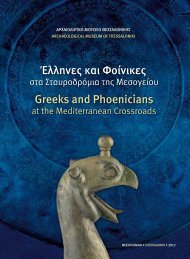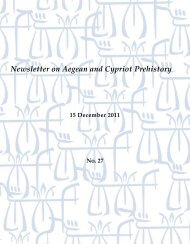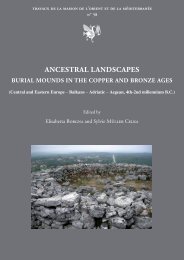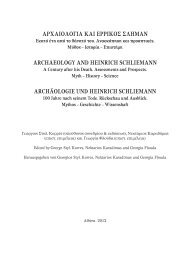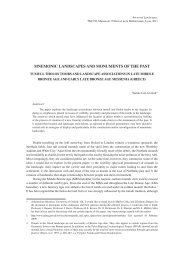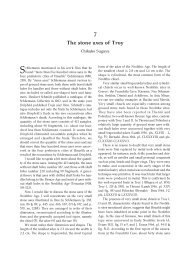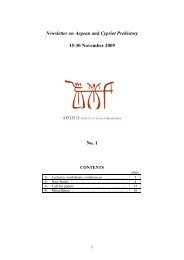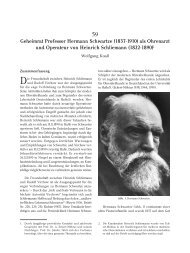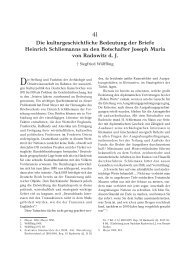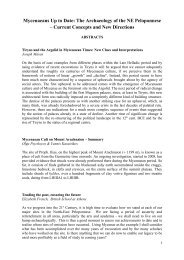You also want an ePaper? Increase the reach of your titles
YUMPU automatically turns print PDFs into web optimized ePapers that Google loves.
528 Hara S. Georgiou<br />
than differences. The nautical terms themselves are<br />
etymologically evocative. It would seem that much of<br />
the naval technology of the Odyssey can be applied to<br />
boats of the Late <strong>Bronze</strong> <strong>Age</strong> such as those in the<br />
Thera painting <strong>and</strong> the excavated wrecks. Certainly,<br />
we do not find in the texts items that appear to be any<br />
more sophisticated technically than those shown in<br />
Late <strong>Bronze</strong> <strong>Age</strong> depictions. The navigational systems<br />
<strong>and</strong> the knowledge of astronomy attested in the<br />
<strong>Homeric</strong> texts are based on Egyptian systems of the<br />
Middle <strong>and</strong> Late <strong>Bronze</strong> <strong>Age</strong>. The introduction of this<br />
knowledge into the Aegean area can most certainly<br />
have occurred before the 8 th c. BC.<br />
The ships of the Late <strong>Bronze</strong> <strong>Age</strong> may have differed<br />
in some respects from those of Homer’s day<br />
(8 th c. BC or later), but the tradition of the sea <strong>and</strong><br />
navigational knowledge is not likely to have changed<br />
much. Moreover, whether two yards or one, we are<br />
dealing with a square sail that will have determined<br />
how close hauled the ship could sail.<br />
Construction <strong>and</strong> the rigging determine the h<strong>and</strong>ling<br />
<strong>and</strong> function of a boat. By comparing the routes<br />
<strong>and</strong> <strong>sailing</strong> practices described in the Odyssey to theoretical<br />
routes based on artifact distribution we can<br />
begin to reconstruct ways in which sea communication<br />
was undertaken. The similarity of artifacts at a<br />
number of sites will not by itself, however, give an<br />
accurate picture of the routes followed or the harbours<br />
used. The type of ship, the effects of the wind,<br />
currents, <strong>and</strong> geography, all must be taken into consideration.<br />
75<br />
Geomorphological studies at present under way<br />
may well alter our picture of a good many coastlines.<br />
76 A reevaluation of some approaches by sail<br />
may be required if it is shown that a different coastline<br />
might have caused changes in local winds or currents.<br />
Yet the prevailing winds <strong>and</strong> wind systems, as<br />
well as the preferred routes <strong>and</strong> approaches to l<strong>and</strong><br />
will have been much as they are for the modem sailor.<br />
In this sense, Homer’s descriptions of seas, winds,<br />
<strong>and</strong> routes are valid even today, <strong>and</strong> both Homer <strong>and</strong><br />
the modern sailor’s experience can be used to help<br />
reconstruct that of antiquity, despite the introduction<br />
since then of different <strong>and</strong> more efficient rigging,<br />
allowing close-hauled <strong>sailing</strong>.<br />
Athens, April 1990<br />
75. Georgiou 1993.<br />
76. Davidson <strong>and</strong> Tasker 1982, 82-94; Kraft et al. 1980, 776-82;<br />
Kraft et al. in this volume; Μendoni <strong>and</strong> Mourtzas 1989.<br />
REFERENCES<br />
Barber, R.L.L., 1987. The Cyclades in the <strong>Bronze</strong> <strong>Age</strong>, London:<br />
Duckworth.<br />
Bass, G.F., 1967. Cape Gelidonya: A <strong>Bronze</strong> <strong>Age</strong> Shipwreck,<br />
Transactions of the American Philosophical Society,<br />
vol. 57, part 8 (Philadelphia).<br />
Bass, G.F., 1987. ‘Oldest known shipwreck reveals splendors<br />
of the <strong>Bronze</strong> <strong>Age</strong>’, National Geographic 172(6):<br />
693-733.<br />
Bass, G.F., Pulak, C., Collon, D. <strong>and</strong> Weinstein, J., 1989.<br />
‘The <strong>Bronze</strong> <strong>Age</strong> shipwreck at Ulu Burun: 1986 Campaign’,<br />
AJA 93: 1-29.<br />
Betts, J.H., 1973. ‘Ships on Minoan seals’, in D. Blackman<br />
(ed.), Marine Archaeology. Proceedings of the 23rd<br />
Symposium of the Colston Research Society held in the<br />
University of Bristol, 4-8 April 1971 (London): 325-326.<br />
Cartledge, P., 1983. ‘Trade <strong>and</strong> Politics revisited: Archaic<br />
Greece’, in Garnsey et al. (eds):1-15.<br />
Casson, L., 1959. The Ancient Mariners: Seafarers <strong>and</strong> Sea<br />
Fighters of the Mediterranean in Ancient Time, London:<br />
Minerva Press.<br />
Casson, L., 1971. Ships <strong>and</strong> Seamanship in the Ancient<br />
World, Princeton, N.J.: Princeton University Press.<br />
Christensen, A.E. <strong>and</strong> Morrison, I., 1976. ‘Experimental<br />
archaeology <strong>and</strong> boats’, Int. J. Nautical Archaeology 5<br />
(4): 275-284.<br />
Cotter, C.H., 1968. A History of Nautical Astronomy, New<br />
York: American Elsevier.<br />
Davidson, D. <strong>and</strong> Tasker, C., 1982. ‘Geomorphological evolution<br />
during the Late Holocene’, in C. Renfrew <strong>and</strong> M.<br />
Wagstaff (eds), An Isl<strong>and</strong> Polity (Cambridge: Cambridge<br />
University Press): 82--94.<br />
Davies, J.K., 1984. ‘The reliability of the oral tradition’, in<br />
Foxhall <strong>and</strong> Davies (eds): 87-110.<br />
Davies, J.K. <strong>and</strong> Foxhall, L., 1984. ‘Afterword’, in Foxhall<br />
<strong>and</strong> Davies (eds): 177-183.<br />
Davis, E., 1983. ‘The iconography of the ships fresco from<br />
Thera’, in Ancient Greek Art <strong>and</strong> Iconography (Madison,<br />
Wisconsin: The University of Wisconsin Press): 3-14.<br />
Digby, A., 1954. ‘Boats <strong>and</strong> ships’, in C. Singer, E.J. Holmyard<br />
<strong>and</strong> A.R. Hall (eds), A History of Technology. I.



